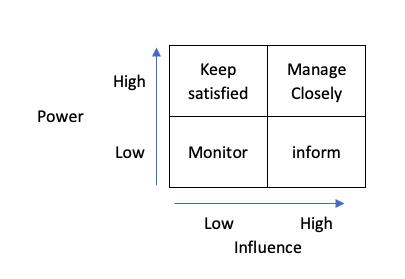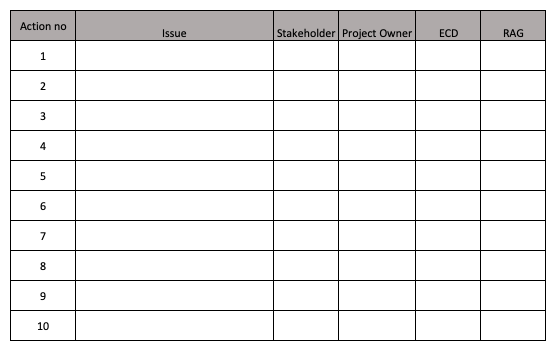When you’re looking to deliver that key project or perhaps you’re trying to grow your business, you can find yourself incredibly disappointed when notwithstanding your efforts you find that you don’t progress as you’d hoped. Perhaps you’re met with resistance when you deliver your project, or maybe you don’t even get the buy-in required to get it off the ground!
Whatever the reason, when you’ve put in a significant effort for something to be a success you can find yourself incredibly frustrated when things fail to develop as planned.
One of the steps of deploying successful projects/growing businesses and reducing the risk of failure is effective stakeholder management. This involves developing plans and methods for managing those people who could perhaps block your project or those that whilst individually may hold little power but as a group can make the difference with you being successful or failing.
Without a doubt, Stakeholders can have a MASSIVE impact and one of the principal processes you need to get to grips with is identifying them, understanding them, communicating with them and ultimately managing their expectations and ultimately delighting them with your deliverable.
But, Why should you devote your time to do this? Because having a structured stakeholder management system will allow you to communicate in an appropriate way so that you can get the best out of them. Stakeholders are not just there to be managed, they can be a huge asset and can contribute to your success.
Luckily, there is a range of tools and templates available that can help you in analyzing your stakeholders. In this post, we’ll cover some of them with a few examples so you see how they can be used.
Firstly let’s look at the basics.
What is a stakeholder
A Stakeholder is an individual or group of individuals that can have a positive or negative impact on your project and/or business and can be affected by it (positively or negatively). Stakeholders can be people at both senior and junior levels and inside or outside your organization/team.
Stakeholders typically have an interest in the business and its actions
Examples of stakeholders include
- Employees
- Customers
- Creditors
- Management
- Supply Chain
- Owners
- Local community
And the list goes on.
When reviewing stakeholders it’s important to consider groups. For example, a single stakeholder may not be able to exert huge influence over your project but a group of similar stakeholders, well that’s a different story!
The next key point to realize is that not all stakeholders are equal, they will have different power, different interests, and different requirements. For example, consider whether the local community and the owners of your business (funding your project) have equal weighting? (clearly, this will vary depending on the topic!!)
Stakeholders typically have a series of attributes associated with them, for example, they:
- Have an interest in the result of a project
- Can have a positive impact on a project
- Can have a negative impact on a project
- Can add risk to a business
- Can create opportunities
Why Analyse your stakeholders
Fundamentally, understanding your stakeholders is key to your business being successful. Consider how many projects can die a death just because you’ve misunderstood the impact of a particular stakeholder group. Looking for an example? How about your boss? Ever had an idea for a fantastic project only for your boss to say “No!”, that’s a great example of not managing your stakeholders!
Stakeholder Management is best seen as a series of process steps, which if followed correctly leads to an action plan that you then execute. Each step has a series of simple tools and templates associated with it.
Execute the process correctly and it can offer you some excellent opportunities e.g.
- Building a robust understanding of requirements.
- Getting approval and resources
- Use stakeholder groups to help shape requirements & plans
How to analyze your stakeholders
The initial phase of stakeholder analysis is one of the fundamental steps in the whole process and it’s crucial that you spend enough time on this element to get your process off to a good start.
Stakeholders can be tricky things to map out. They can be independent, or they can be related, they can be in groups and their importance and influence can vary considerably. For example, you may have groups of stakeholders – you could consider a Logistics group of stakeholders that could include supply chain, distribution, and associated support services, reviewed independently their influence may not be considerable but as a group, they may be your highest priority!
There are a number of steps involved in the process
1/ Identifying your stakeholders
2/ Understanding needs and requirements
3/ Understanding power and influence
4/ Ranking them with power and influence.
5/ Developing an action plan
Let’s look at each step.
1/ Identifying your stakeholders
Whilst you may think that this is the easy bit, this can prove challenging. Traditionally, this is where good old brainstorming comes in.
As always brainstorming is best done in a group. So get your project team together and make a list of your stakeholders (don’t try and rank them at this stage). Think of internal and external stakeholders.
As ever with brainstorming, everyone’s input at this stage is valid, there is no right or wrong, you simply need to capture everyone’s ideas.
You’ll probably find that you come up with a mixed list of groups and individuals (i.e. “customers”, “The boss”). That’s ok the key thing is that you try and develop as much of a complete list as possible.
In practical terms, I find that this is often done best with sticky notes and a whiteboard. Get your colleagues to populate their sticky notes with ideas and then get everyone to then populate the whiteboard. The advantage of this approach is that you can move the notes around the board and group them.
Once you’ve got an agreed list of stakeholders jot them down onto a list spreadsheet for the next step.
2/ Consider your stakeholder’s needs.
When you’re considering your stakeholder needs this generally presents you with a great place to start from with regard to identifying (or double checking) your projects/business deliverable that your implementing.
Getting your stakeholder needs accurately defined so you know which are conditions that have to be met and what are the nice to haves can be challenging – your analysis should define those requirements that are absolutely required for your project to be a success.
One of the best ways of doing this is to utilize a matrix that tabulates
- Key details about the stakeholder
- The stakeholder grouping
- Key needs
- Why they might block the project
- Strategies for Engaging with the stakeholder
A method for tracking this is shown below

Using this table (or a variant thereof) can add structure to your process and avoid missing anything critical.
3/ Work out their power and influence
Another element of the stakeholder that you should be reviewing is that of their power and influence. By doing this you’re enabling yourself to focus your efforts on the key stakeholders/groups that have key influence over the success of your project.
While you might have a desire to treat all your stakeholders the same this could be detrimental to your success, primarily because you are unlikely to be able to devote your resources effectively to managing them all.
There are a variety of methods for undertaking this task – one common one is to use a Power/Influence grid.
We’ve shown an example below – using this grid you’d place your stakeholders into one of four boxes on a grid which would then help you define your management process for them.

4/ Rank them in accordance with power and influence.
By this stage, you’ve got an understanding of your stakeholders, who they are, what group they belong to and an understanding of their needs. The next step is to rank them. Why should you do that? Most businesses/projects are limited by resources and want to ensure any energies spent are focused appropriately and get the maximum return. To support this you need to prioritize engagement with your stakeholders. You do this by ranking them in importance.
You can use your analysis at point 2 (expanding on the template as necessary) to help you determine your ranking enabling you to devise your strategy which can include:
- How will you communicate to each identified stakeholder (or group?)
- Determine communication media and style best suited for each stakeholder
Below you can see how we’ve modified our stakeholder analysis template we created at stage 2 for this purpose (we’ve shown the new columns in green on the image).

5/ Developing an action plan.
Now that you thoroughly understand your stakeholders the next step is to devise a management plan. This will probably include elements such as
- Communication strategy
- Engagement/Consultation strategy
- Risk capture and management
- Success planning
Your action plan is likely to look like a typical to do list with the action, the owner, the target date for completion – this will be reviewed periodically with an update loop into the formal project plan.
You can see this in our example Stakeholder Action Template below.

Summary
So there you have it – a few stakeholder analysis tools and an overview of the process.
Without a shadow of a doubt, stakeholder analysis is one of the key steps in the success of any project, it can help smooth the path for a successful implementation and help you meet your user’s needs. Get it wrong and you might find that at best your plan slips while you play catch up and accommodate requirements, at worst getting it wrong can stop you dead in your tracks.
So there’s our post on How to do Stakeholder analysis. Have some comments or feedback? We’d love to hear them in our feedback section below or send us a message on Twitter.
This post is part of our Management & Leadership guide. Check it our for further Management tips, tools and templates.